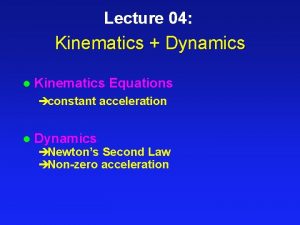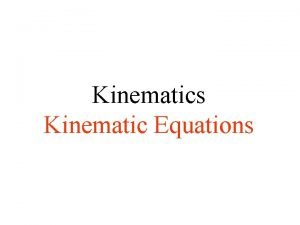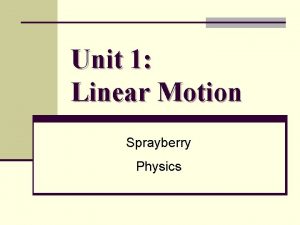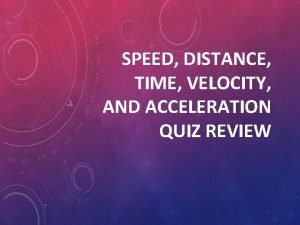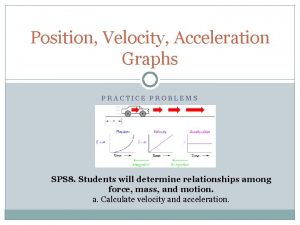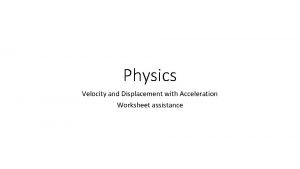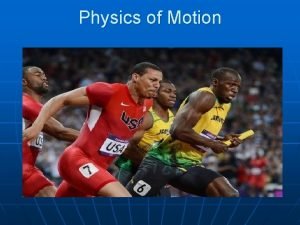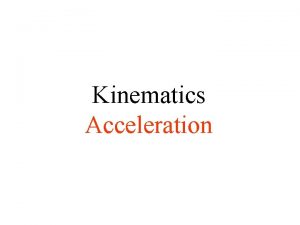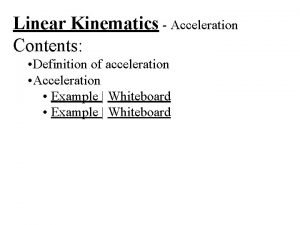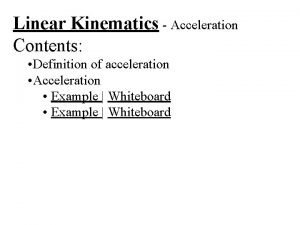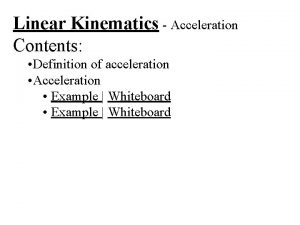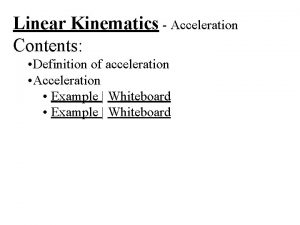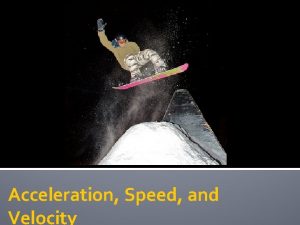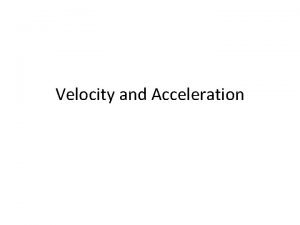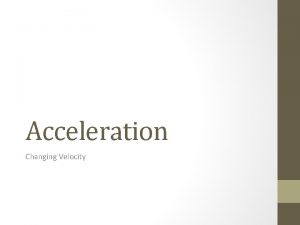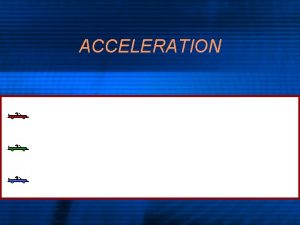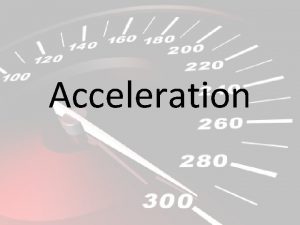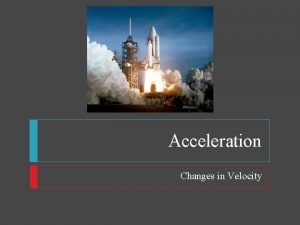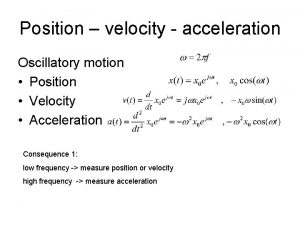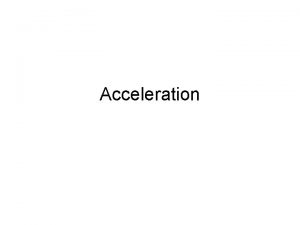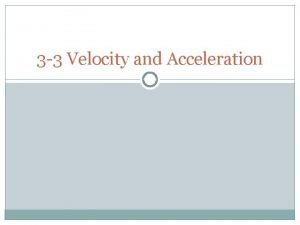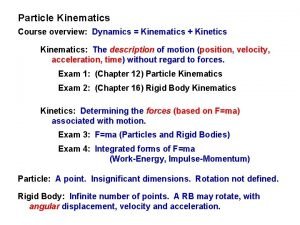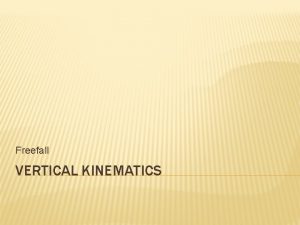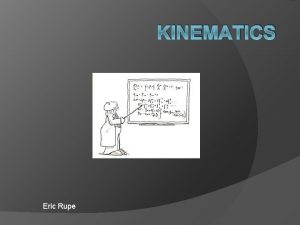Velocity and Acceleration Kinematics 1 Velocity Velocity is



















- Slides: 19

Velocity and Acceleration Kinematics 1

Velocity • Velocity is a vector which measures the change in the position of an object with relation to time. • It has magnitude and direction. • Speed is a scalar quantity which measures the magnitude of an object’s velocity. • It has only magnitude. • This means… 1. Speed is always positive while velocity can be negative. 2. Displacement is used for velocity. 3. A change in direction is a change in velocity.

Types of Speed • Constant Speed is where there is no rate of change in position. • Average Speed is the total distance traveled over the time elapsed. • The speed of a moving object is not always constant. Average speed ignores this and calculates the mean without rate changes. • Instantaneous Speed is the measure of speed at a particular moment in time • Speedometers are an example

Acceleration • Acceleration is a vector which measures the change in the velocity of an object. • It has magnitude and direction. • This means acceleration could be any of the following three… 1. a change in speed, the magnitude of the velocity (from 34 km/h to 67 km/h) 2. a change in direction (from East to North. East) 3. a change in both speed and direction (from 34 km/h East to 12 km/h West)

Acceleration • When an object has acceleration, it covers a different distance each second it is in motion. • Remember: Constant velocity means an object in motion covers the same distance each second it is in motion.

• Which car or cars (red, green, and/or blue) are undergoing an acceleration? Study each car individually in order to determine the answer. • Which car (red, green, or blue) experiences the greatest acceleration?

Consider the position-time graph below. Each one of the three lines on the position-time graph corresponds to the motion of one of the three cars. Match the appropriate line to the particular color of car.

Graphing • Remember: A position vs. time graph that shows a constant velocity has a linear slope • A position vs. time graph that shows a changing velocity has a curved slope.

Velocity- Time Graphs Notes • A velocity time graph tells us the speed of an object in a given period of time and is based on position time data. • The slope of a velocity time graph is acceleration. • The graph also gives a picture of the initial and final velocity of an object

Usain Bolt 12. 2 m/s or 27 mph

Understanding Velocity Time Graphs

Constant Acceleration • Occurs when an accelerating object changes its velocity by the same amount each second • An object with a constant acceleration should not be confused with an object with a constant velocity • If the velocity is changing, then the distance traveled/time is not a constant value

Average Acceleration • Acceleration is the rate at which velocity changes • A rate quantity means that time is in the denominator a = acceleration vf= final velocity vi = initial velocity t = time

Acceleration Units • Units for velocity • m/s • Km/h • mph • Acceleration is velocity/time so units include • m/s/s or m/s 2

Direction of Acceleration • Direction depends on two things • If the object is speeding up or slowing down • If the object is moving in a positive or a negative direction • Acceleration is positive when. . . • The object is speeding up • The object is moving in a positive direction (forward) • Acceleration is negative when. . . • The object is slowing down • The object is moving in a negative direction (backward)

Example A bus traveling at 30 km/h speeds up at a constant rate of 3. 5 m/s 2. What velocity does it reach 6. 8 seconds later? How can we rearrange this equation to solve for vf?

Kinematic Equations • We can use variations of the basic velocity equation and solve for the variables time, final velocity, initial velocity, distance, and acceleration. • Foldable Instructions

Useful Equations •

 Aplusphysics kinematics-horizontal kinematics
Aplusphysics kinematics-horizontal kinematics Is v final velocity
Is v final velocity Constant acceleration speed time graph
Constant acceleration speed time graph Kinematic equaitons
Kinematic equaitons Kinematic equations
Kinematic equations Kinematics of rigid body
Kinematics of rigid body Angular acceleration formula
Angular acceleration formula Kinetic angular energy
Kinetic angular energy Tangential acceleration and centripetal acceleration
Tangential acceleration and centripetal acceleration Centripetal acceleration vs centripetal force
Centripetal acceleration vs centripetal force Is radial acceleration the same as centripetal acceleration
Is radial acceleration the same as centripetal acceleration Jacobian
Jacobian Difference between velocity and acceleration example
Difference between velocity and acceleration example Velocity
Velocity Speed velocity and acceleration quiz
Speed velocity and acceleration quiz Speed, velocity and acceleration problems
Speed, velocity and acceleration problems Relative velocity si unit
Relative velocity si unit Positive velocity and negative acceleration graph
Positive velocity and negative acceleration graph Displacement velocity and acceleration worksheet
Displacement velocity and acceleration worksheet Difference between velocity and acceleration
Difference between velocity and acceleration



